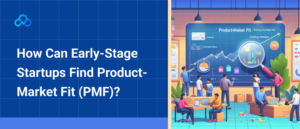How Can Early-Stage Startups Find Product-Market Fit (PMF)?
1. Introduction
Finding product-market fit (PMF) is one of the biggest challenges for early-stage startups.
Without it, scaling a business is nearly impossible. But what exactly does PMF mean?
PMF happens when a product satisfies a strong market demand. It’s the sweet spot where
customer needs align with the value of a product. Many startups struggle to reach this stage. However, using an effective strategy, such as developing a Minimum Viable Product (MVP), helps validate market needs before making big
investments.
2. Understanding MVP Meaning in Business
Minimum Viable Product (MVP) refers to a product with essential features only, and it is the simplest version of the final
product. It enables start-ups to be able to have an early feel of what the market has to
incorporate in their products while incurring little costs.
3. MVP services help businesses:
● Validate market demand early
● Gather customer feedback
● Avoid unnecessary features
● Improve product iterations
4. Why Is Product-Market Fit Important?
PMF is an essential test for recognizing the start-up companies’ ability to grow sustainably.
Some of the primary issues that businesses face and for which they will have difficulty in
maintaining their customers’ patronage and achieving steady revenues when there is no PMF in
place.
Benefits of achieving PMF:
● Higher customer retention rates
● Increased word-of-mouth referrals
● More efficient marketing strategies
● Stronger investor interest
5. Step-by-Step Guide to Finding Product-Market Fit
5.1. Define Your Target Audience
For a startup, it is crucial to know its target clients or customers. This indicates that when the
organization or the marketing team is not clear on its target market, achieving the PMF becomes
a challenge.
Some of the ways used to define the right audience:
● Conduct surveys and interviews
● Analyze competitors’ customer base
● This is in line with the use of market research tools such as Google Trends or any other
social insights.
5.2. Steps to Establish an MVP Development Services
(Minimum Viable Product) MVP development services focus on providing organized ways for constructing and especially
testing the first versions of a product.
Startups should:
● Focus on one key problem
● Develop only essential features
This is a strategy that helps a firm to test a simple prototype before going on to launch it as a
full-blown product.
5.3. Test Your MVP with Early Adopters
First movers are very helpful in the validation process of the usefulness of the product that is
being developed. They are people who are ready to implement innovations as such people can
share their observations.
Customer service is especially paramount in this phase and the Minimum Viable Product (MVP) must have a customer
service that is more than adequate. Engaging early users helps:
● Accumulate information regarding best practices and pilot errors.
● Identify usability issues
5.4. Analyze Customer Feedback
In a startup, it is crucial to always hear from the customers to have a better understanding of
their feelings concerning the product. Some of the feedback that must be sought includes:
● Surveys and polls
● Social media engagement
● Reviews and testimonials
Feedback analysis should focus on:
● Recurring issues faced by users
● Commonly requested features
● Customer sentiment toward the product
5.5. Iterate Based on Data
Making changes in the Minimum Viable Product (MVP) is possible and this is enhanced through iteration. After collecting
feedback, startups should:
● Identify patterns in customer behavior
● Modify features accordingly
● Make the user experience better and more enhanced with each version.
Successful iteration cycles involve:
● Prioritizing high-impact improvements
● Adapting alterations with a lesser number of potential customers
● Monitoring engagement metrics post-update
5.6. Study Minimum Viable Product Examples
Here are some successful examples of Minimum Viable Product:
● Airbnb: Originally to have set up a basic internet platform for short-term apartment
renting to confirm the needs of the market.
● Zappos: They used the website initially to sell shoes and delivered the shoes personally
to the customer to determine the interest of the customers.
● Spotify: Offered a new ‘Freemium’ service to gauge the appetite of their consumers
before entering the new business of online music streaming.
● Instagram: Initially developed as a check-in application but adjusted to a photo-sharing
application owing to its users’ responses.
5.7. Monitor Key Metrics for PMF
Measuring the right variables assists in identifying if a startup has attained the PMF. Key
indicators include:
● Customer Retention: The high CRM measure indicates that the company has a good
match between the offered products and the target markets.
● Customer Loyalty (CL): Assess the extent to which customers will endorse the product
with others.
● Organic Growth: This is a type of growth that stems from the recommendations of
individuals or is kick-started by the recommendations of some personalities or
institutions.
● Engagement Metrics: Active users, session duration, and feature usage.
5.8. Scale When You Achieve PMF
The regular sign of achieving PMF for a startup appears when the process gains consistent
progress. Indicators of PMF include:
● Strong user retention rates
● Organic word-of-mouth growth
● High customer satisfaction scores
● Increased revenue with lower customer acquisition costs
At this stage, the following are the areas in which startups can invest:
● Expanding product features
● Scaling marketing efforts
● Seeking additional funding from investors
● Improving operational efficiency
6. Common Mistakes Startups Make When Searching for PMF
Various mistakes are often made by startups in the course of their operation that lead to their
inability to discover PMF. Avoid these pitfalls:
● Building Too Many Features Too Soon: Start with a simple MVP instead of an
overloaded product.
● Feedback from the customer: The process of constant application upgrades based on
customers’ needs must not be neglected.
● One key reason is that social media followers do not equate to PMF, which is why it is
always advisable to focus on meaningful metrics rather than vanity metrics.
● Customer service is a critical component of any business, but an MVP business focuses
its energies on the wrong side of customer service by avoiding it.
● Pivoting too late or too early is a huge mistake, which should be replaced with calculated
decisions based on result analysis.
7. The Evolution of PMF
The process of PMF is not just a one-time effort but is an ongoing process. It is common to find
some of these startups get to this stage and struggle to grow beyond it. The evolution of PMF
involves:
The three frameworks are:
● Problem-Solution Fit – Ensuring the product addresses a real market issue for a
specific customer group.
● Product-Market Fit – Successfully developing a solution that resonates with a broad
customer base.
● Growth-Product Fit – Aligning the product with sustainable growth strategies.
Each of them needs constant checking, trial, and redesign in response to users’
behavior and market conditions.
8. Deep Market Research: The Foundation of PMF
Here, the last element to understand is that market research is more than simply analyzing
competitors for their feasibility. Any startup must also have very clear and deep knowledge of
their customer’s preferences and pains.
Methods for Conducting Market Research:
● Customer Development Interviews – the interviews are conducted with the potential
customers to know their requirements.
● Jobs-to-be-Done (JTBD) Framework – You must discover what job the customer is
seeking to accomplish through using your product.
● Players – Analyze the drawbacks in competitors’ offerings and exploit them to one’s
advantage.
● Social Listening – Relate it to Twitter, Reddit, Quora, and other forum and discussion
sites to read the signals of the industry.
9. Designing a Smart Minimum Viable Product Strategy
An MVP is not simply a bare-bones product. In short, a well-designed MVP helps startups check
hypotheses and demand for the core values to be provided so that their business can exist in
the first place.
Advanced Minimum Viable Product Strategies:
● Work and Gather Feedback – Used for creating landing pages, advertisements, or
waiting lists before building an MVP.
● Concierge MVP – It should provide a cheaper and manual version of the product before
developing a product.
● Wizard of Oz MVP – Create an autonomous interface for a system that works on the
back end with the help of human operators.
● Feature-Based MVP – Choose one key feature and release the application with just that
feature to test its potential before adding more.
Using the right MVP, startups extend the concept of wasting fewer resources, gaining more
high-quality feedback, and increasing efficiency.
10. Conclusion
As established by some of the veterans in the technology industry, getting a product-market
match is a process and not an event. MVPs need to be created, users’ opinions have to be
obtained and incorporated rapidly, and market responses have to be assessed. Increasing
success rates can be facilitated through the use of MVP services, a customer-centered
approach, and research on the use of MVP examples.
Do you like to read more educational content? Read our blogs at Cloudastra Technologies or contact us for business enquiry at Cloudastra Contact Us.

